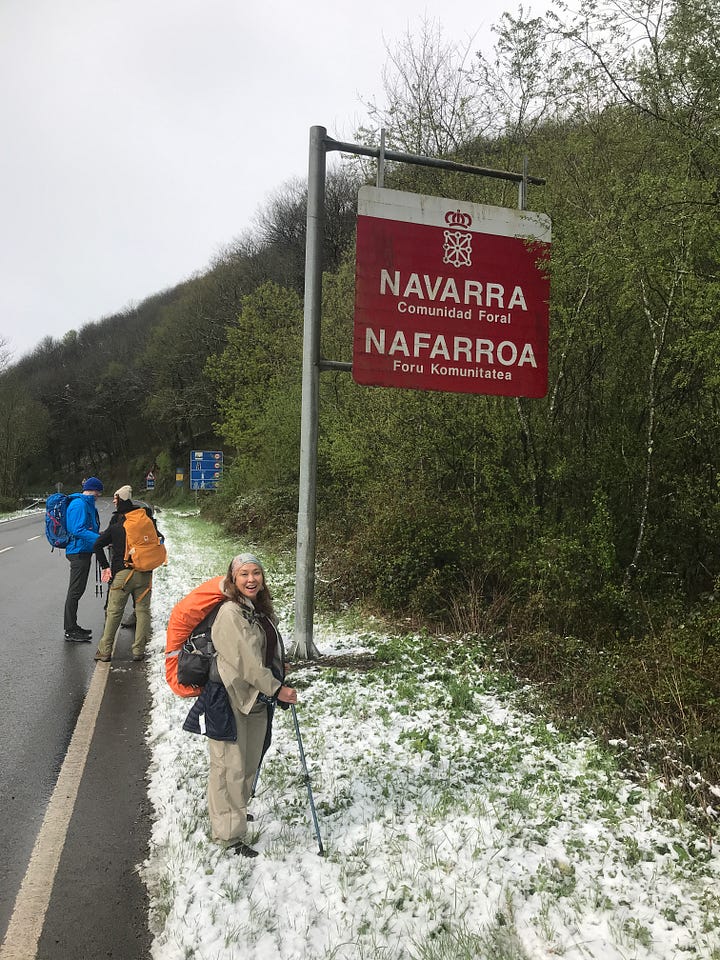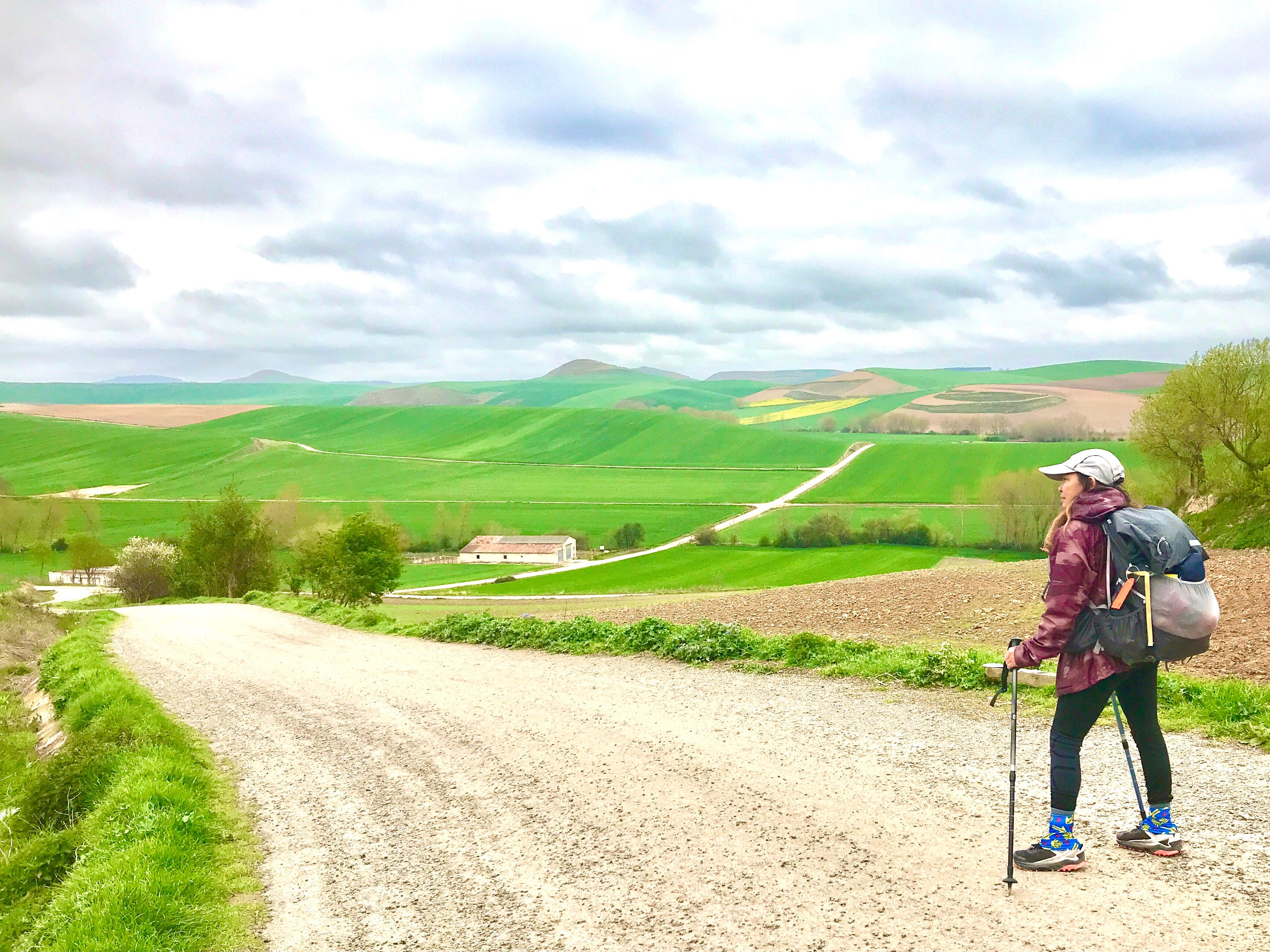Burned Out and Bummed Out in Spain: Camino de Santiago for Beginners (1)
Part one of a four-part series. This is a five minute read.
If you find yourself burned out and in need of a hard reset, or an adventure, or a potential miracle, I highly recommend going on a very, very long walk. I did just that, for 37 days and close to 500 miles on the epic Camino de Santiago (The Way of Saint James), a centuries-old network of walking trails throughout Europe. One of them, the Camino Francés or the French Way, begins in Saint Jean Pied de Port, France, a small town at the foot of the Pyrenees. The French Way is the so-called classic trail that most beginners choose. All trails lead to the Galician town of Santiago in Northern Spain, where the relics of Saint James (Santiago in Spanish) lay. They say a pilgrimage to Santiago can be life-changing. It certainly was for me.
Burned out and bummed out by my middle-aged, pandemic-controlled life, I found myself with a rare gift: at least one month to spend as I wished. I pivoted from Northern California suburbia to Spanish countryside.
I wanted the romance of being a solitary seeker traversing remote trails, on a quest for miraculous ancient relics. I needed a Raiders of the Lost Arc-slash-Eat Pray Love moment.
A WINTER MIRACLE, TOUT DE SUITE
I spent days and hours obsessively watching videos and reading blogs on how to do this Camino de Santiago. I didn’t want a package tour and be driven around to restaurants and wine-tasting. I wanted the romance of being a solitary seeker traversing remote trails, on a quest for ancient relics. I needed a Raiders of the Lost Arc-slash-Eat Pray Love moment. I was looking for miracles.
I got my first miracle within my first hour on my first day on trail at Saint Jean Pied de Port, France. I was hiking up a hill and was close to the top, when I heard the faint sound of people yelling. I ignored them. Annoyed by the persistent yelling, I stopped and look down the hill. Two people, screaming in another language, were waving at me to come back down. They pointed to a trail leading to a valley. I descended the hill I just climbed, irritated. (Mistake: No situational awareness. Not using a navigating app.)
Later, I found myself in a forested area, hiking through a beautiful and frightening snowstorm. I had managed to avoid snow all my life, now here I was. As I crossed the border from France to Spain through snowfall with 20 pounds on my back (Mistake: Overpacking. Overtaxing your body.), I was grateful for the company of other pilgrims going through this challenge with me. (Tip: When in doubt, join a group)


To this day, I shudder to think what might have happened had I continued up that hill in France, and been caught in that snowstorm lost and alone. Yes, those two people pointing me in the right direction was a miracle that probably saved my life.
COSTLY MISTAKES, CULTURE SHOCK
As we trudged on, I witnessed the biggest problem that plagues hikers on the Camino. One of my new friends from Australia was limping, trying to power through pain. We convinced him to stop and look at his foot. And so, right there, by the side of a freeway, he took his shoe off, revealing what we had all suspected was causing him pain. His sister popped that big, red, juicy blister and applied an antibiotic cream and band-aid. (Mistakes: Using ill-fitting shoes or shoes that haven’t been broken in. Ignoring pain.)
Our day ended in an ancient pilgrim albergue (hostel) built in 1127 in Roncesvalles in Navarra, Spain. I paid less than 15 euro for a bed. After a hot shower and popping an ibuprofen, I had a hearty, simple meal in a dining hall full of happy, relieved pilgrims from all over the world who had just survived a snowstorm together—what an epic first day!
After dinner, culture shock in the mixed dormitory-style sleeping situation with about fifty other people. A tired and cranky pilgrim scolded some women who were talking. People were fiddling with gear. People were snoring. People were talking in their sleep. I was so exhausted, that I fell asleep anyway. I probably snored and talked in my sleep too.
As they say, “We pack our fears.” Flashback to two to three weeks, pre-departure: It was a frenzy of buying and returning items from Amazon and REI.
My first major executive decision on Day 2 was to leave behind or give away as much gear as I could, to lighten my load. I said good-bye to an unused new tripod. A rain jacket and torn rain pants. A backpack cover used for a few hours. A brand-new, unused, extension cord. I left behind close to a hundred dollars’ worth of unnecessary gear. Ugh.
Don’t overpack! As they say, “We pack our fears.” The Camino de Santiago’s most beginner-friendly trail, the Camino Frances or the French Way, is so supported by stores and services for pilgrims every few miles that it makes no sense to be so fully geared up.
Flashback to two to three weeks, pre-departure: It was a frenzy of buying and returning items from Amazon and REI. I heard and read so much general advice about what kind of gear to get, that I obviously overdid it. (Mistake: Preparing as if hiking in the wilderness.)
Meantime, as I hiked out to my next destination, I did a quick check-in: I was excited, a little anxious and fearful, sore and definitely not burned out. I was feeling alive again!
At the end of this four-part series, I’ll be sharing my best practices and favorite gear.
Next week: Flirting with roommates. Oh hello, Pamplona!
I offer a free consultation for beginners to the Camino de Santiago (Camino Francés). Whether you’re still thinking about walking your first Camino, or are already committed to doing it, but need to know how to get started, e-mail me at contact@beginnersmind.life. Or, if you’re dreaming about solo travel, send me questions too. Beginners only please!





